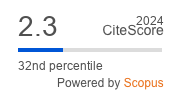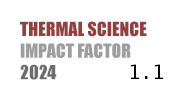ABSTRACT
Solution of radiative intensity plays an important role in many areas, such as combustion monitoring, fire detection, and infrared imaging simulation, etc. The reverse Monte Carlo method is a widely used method due to its high accuracy and flexibility. However, it has not been applied to solve radiative intensity in systems discretized by unstructured grids which are usually applied in complex geometries. This brings difficulty if the solution of radiative intensity is applied to practical radiative systems of irregular geometries, especially coupled with other physical problems, such as fluid flow, etc. In this work, the reverse Monte Carlo method based on unstructured grids is developed for solving radiative intensity in participating media with complex geometries. In order to improve the efficiency of ray tracing process, a preprocessing procedure is introduced to establish topological relationships between unstructured grids. Radiative heat flux and radiative intensity in radiative systems with different geometries of a cube and a triangular prism are calculated. Comparing with results of other methods in literatures, radiative heat flux and radiative intensity calculated by the present method shows very good accuracy.
KEYWORDS
PAPER SUBMITTED: 2024-12-27
PAPER REVISED: 2025-02-24
PAPER ACCEPTED: 2025-02-26
PUBLISHED ONLINE: 2025-04-05
- Zhou, H.-C., et al., Experimental investigations on visualization of three-dimensional temperature distributions in a large-scale pulverized-coal-fired boiler furnace, Proceedings of the Combustion Institute, 30. (2005), 1, pp. 1699-1706
- Liu, D., et al., Experimental reconstructions of flame temperature distributions in laboratory-scale and large-scale pulverized-coal fired furnaces by inverse radiation analysis, Fuel, 93. (2012), pp. 397-403, DOI No. 10.1016/j.fuel.2011.09.004
- Calle, A., et al., Fire detection and monitoring using MSG Spinning Enhanced Visible and Infrared Imager (SEVIRI) data, Journal of Geophysical Research: Biogeosciences, 111. (2006), G4, DOI No. doi.org/10.1029/2005JG000116
- Bordbar, H., et al., Flame detection by heat from the infrared spectrum: Optimization and sensitivity analysis, Fire Safety Journal, 133. (2022), p. 103673, DOI No. doi.org/10.1016/j.firesaf.2022.103673
- Zhou, Y., et al., A numerical simulation method for aircraft infrared imaging, Infrared Physics & Technology, 83. (2017), pp. 68-77, DOI No. doi.org/10.1016/j.infrared.2017.04.011
- Mo, D., et al., Similarity criteria of target thermal radiation characteristics and their application to infrared radiation of jet engine exhaust system, International Journal of Thermal Sciences, 125. (2018), pp. 358-368, DOI No. doi.org/10.1016/j.ijthermalsci.2017.12.003
- Huang, K.,X. Mao, Detectability of infrared small targets, Infrared Physics & Technology, 53. (2010), 3, pp. 208-217, DOI No. doi.org/10.1016/j.infrared.2009.12.001
- Walters, D.V.,R.O. Buckius, Monte Carlo methods for radiative heat transfer in scattering media, Annual Review of Heat Transfer, 5. (1994), pp. 131-176
- Farmer, J.T.,J.R. Howell, Monte Carlo prediction of radiative heat transfer in inhomogeneous, anisotropic, nongray media, Journal of Thermophysics and Heat Transfer, 8. (1994), 1, pp. 133-139
- Fiveland, W.A., Discrete-Ordinates Solutions of the Radiative Transport Equation for Rectangular Enclosures, Journal of Heat Transfer, 106. (1984), 4, pp. 699-706
- Truelove, J.S., Three-dimensional radiation in absorbing-emitting-scattering media using the discrete-ordinates approximation, Journal of Quantitative Spectroscopy and Radiative Transfer, 39. (1988), 1, pp. 27-31, DOI No. 10.1016/0022-4073(88)90016-7
- Cheng, P., Dynamics of a radiating gas with application to flow over a wavy wall, AIAA Journal, 4. (1966), 2, pp. 238-245, DOI No. 10.2514/3.3424
- Mengüç, M.P.,R. Viskanta, Radiative transfer in three-dimensional rectangular enclosures containing inhomogeneous, anisotropically scattering media, Journal of Quantitative Spectroscopy and Radiative Transfer, 33. (1985), 6, pp. 533-549, DOI No. doi.org/10.1016/0022-4073(85)90021-4
- Raithby, G.D.,E.H. Chui, A Finite-Volume Method for Predicting a Radiant Heat Transfer in Enclosures With Participating Media, Journal of Heat Transfer, 112. (1990), 2, pp. 415-423
- Modest, M.F.,S. Mazumder, Radiative Heat Transfer. Academic Press, 2022
- Cheng, Y., et al., Solution of radiative intensity with high directional resolution in heterogeneous participating media and irregular geometries by the null-collision reverse Monte Carlo method, International Journal of Heat and Mass Transfer, 152. (2020), p. 119475, DOI No. doi.org/10.1016/j.ijheatmasstransfer.2020.119475
- Wang, F., et al., Efficient inverse radiation analysis of temperature distribution in participating medium based on backward Monte Carlo method, Journal of Quantitative Spectroscopy and Radiative Transfer, 109. (2008), 12-13, pp. 2171-2181, DOI No. 10.1016/j.jqsrt.2008.03.002
- Kalos, M.H.,P.A. Whitlock, Monte Carlo Methods. Wiley, 2008
- Fan, C., et al., An unstructured Monte Carlo ray-tracing method for solving radiative heat transfer in 3D gray semitransparent medium, Journal of Quantitative Spectroscopy and Radiative Transfer, 225. (2019), pp. 110-118, DOI No. doi.org/10.1016/j.jqsrt.2018.12.035
- Sakami, M., et al., Radiative heat transfer in three-dimensional enclosures of complex geometry by using the discrete-ordinates method, Journal of Quantitative Spectroscopy and Radiative Transfer, 59. (1998), 1, pp. 117-136, DOI No. doi.org/10.1016/S0022-4073(97)00023-X
- Grissa, H., et al., Prediction of radiative heat transfer in 3D complex geometries using the unstructured control volume finite element method, Journal of Quantitative Spectroscopy and Radiative Transfer, 111. (2010), 1, pp. 144-154, DOI No. doi.org/10.1016/j.jqsrt.2009.07.006

